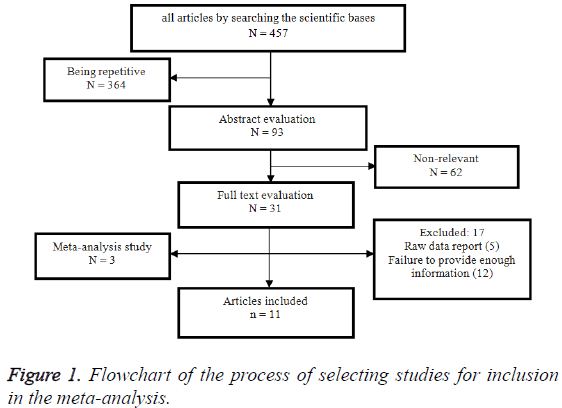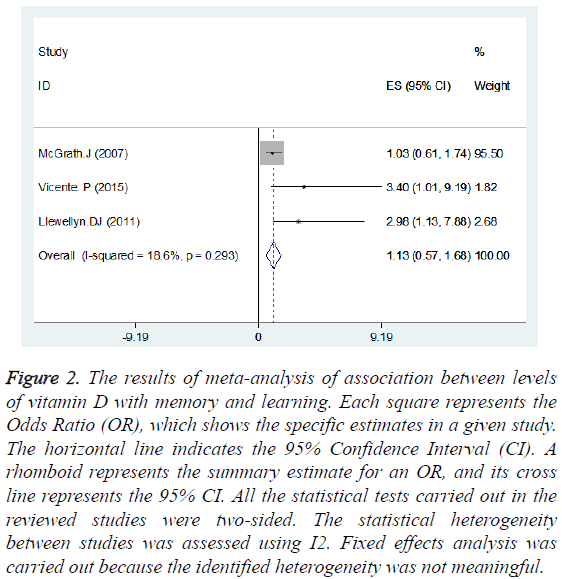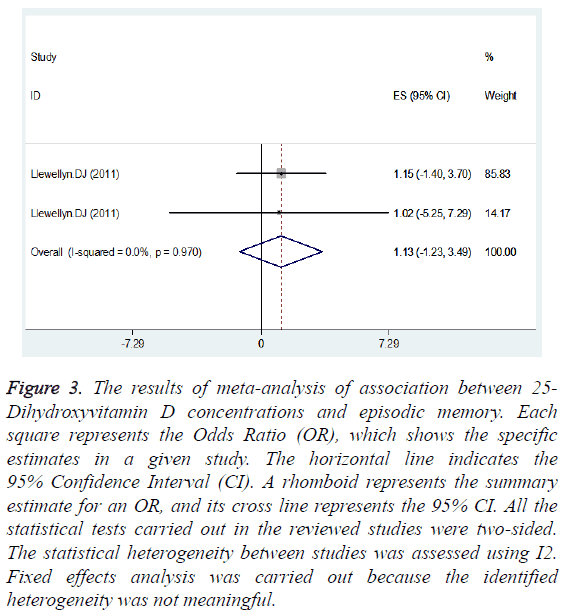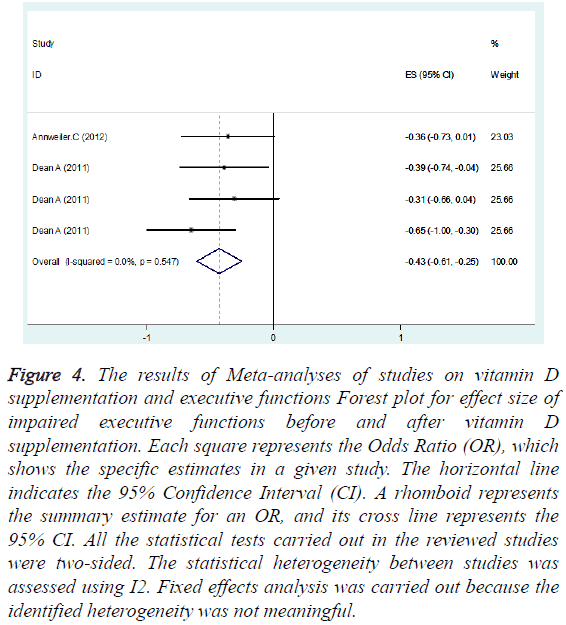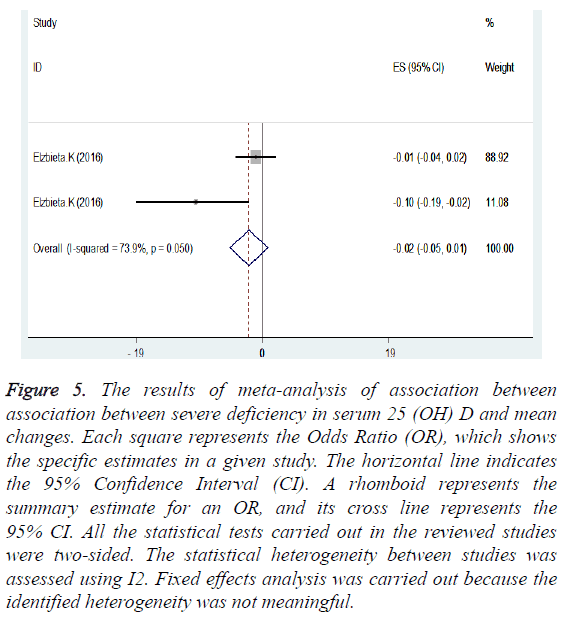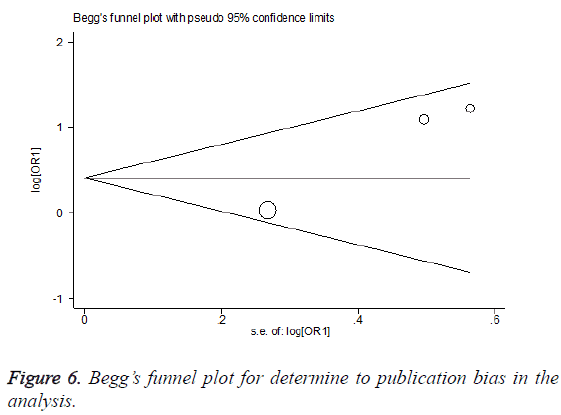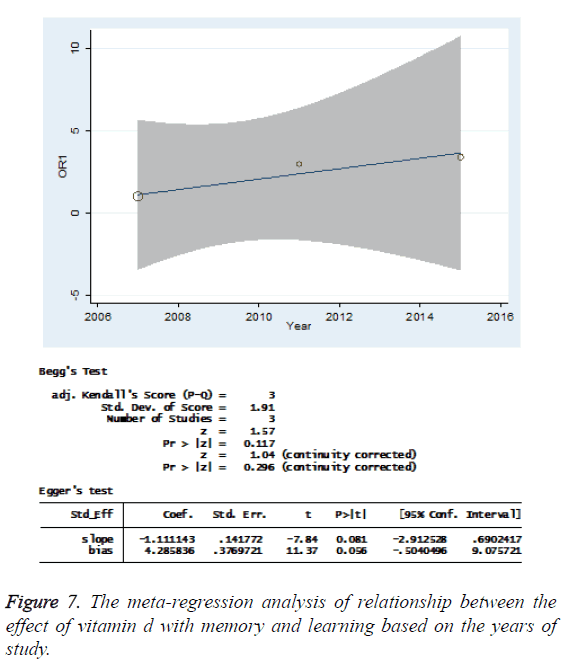Review Article - Biomedical Research (2017) Volume 28, Issue 17
Vitamin D and its association with memory and learning: A systematic review and meta-analysis
Mansour Amraei1, Roudabeh Mohamadpour2, Ardeshir Moayeri3, Naser Abbasi4, Ehsan Shirzadpour5 and Mojtaba Mohamadpour2*
1Department of Physiology, Faculty of Medicine, Ilam University of Medical Sciences, Ilam, Iran
2Department of Epidemiology, Prevention of Psychosocial Injuries Research Center, Ilam University of Medical Sciences, Ilam, Iran
3Department of Anatomy, Faculty of Medicine, Ilam University of Medical Sciences, Ilam, Iran
4Biotechnology and Medicinal Plants Research Center, Faculty of Medicine, Ilam University of Medical Sciences, Ilam, Iran
5Department of Biochemistry, Faculty of Medicine, Ilam University of Medical Sciences, Ilam, Iran
- *Corresponding Author:
- Mojtaba Mohamadpour
Department of Epidemiology
Prevention of Psychosocial Injuries Research Center
Ilam University of Medical Sciences, Iran
Accepted date: July 20, 2017
Abstract
Vitamin D, which can protect the nervous system, has been associated with increased learning and memory function in studies that have also confirmed a relationship between hypovitaminosis D and cognitive decline. Clinical research, however, has not been promising in this regard and has failed to verify the association between increased vitamin D levels and improved cognitive outcomes. To address this gap, a systematic review and a meta-analysis were conducted to determine the relationship of vitamin D with learning and memory. For this purpose, the ISI, PubMed, and SCOPUS databases were searched for related studies published from 2000 to 2016. The keywords “vitamin D”, “1, 25- dihydroxycholeclciferol”, “learning”, “memory”, “memory disorders”, “Alzheimer’s disease”, “executive function disorders”, “concentration difficulty”, “cognitive impairment”, “dementia” and “psychiatric test” were used in the search. The data is then analyzed using random-effects meta-analysis model and Stata version 11.2. A total of 11 studies were included in the final analysis. Results showed that although serum levels of vitamin D were positively correlated with memory, learning, and improved cognitive and executive dysfunction, this relationship was not significant (summary OR=1.13, 95% CI: 0.57, 1.68). On the basis of years of study, no correlation was found between the effects of vitamin D and memory and learning. Our findings support the association between serum levels of vitamin D and memory, learning, and improved executive cognitive dysfunction despite the lack of significance in such relationship. These findings emphasize the need for strategies to prevent cognitive and executive dysfunction in patients with severe vitamin D deficiency.
Keywords
Vitamin D, Cognitive function, Executive function, Memory, Learning, Meta-analysis.
Introduction
Dementia (Alzheimer’s disease) is one of the most important public health problem in the world. Its prevalence is expected to increase three-fold because of the rise in the global aging population by 2050 [1]. Another widespread health issue is vitamin D deficiency, with a prevalence of approximately 1 billion people worldwide [2]. Hypovitaminosis D diminishes vitamin D activity in a variety of organs, including the central nervous system [2-5]. Bodily requirements for vitamin D are fulfilled through diet or synthesis in the skin epidermis [6]. Vitamin D is a fat-soluble steroid that serves a special role in maintaining healthy bones through the regulation of calcium metabolism [3]. In addition to being involved in calcium absorption and bone health, vitamin D can affect the functioning of all bodily systems because both vitamin D receptors and the enzyme that converts 25-OHD to the active form of the vitamin (1, 25- dihydroxyvitamin D or calcitriol) are expressed in all organs, including the brain. Given the expression of vitamin D receptors in the brain and their synthesis of the active form of the vitamin, the cognitive strengthening activities of vitamin D may represent primary effects in the brain rather than secondary systemic effects [7]. Additionally, calcitriol can be bonded with membrane-bound receptors and non-genetic functions, such as calcium transmission through voltagegated ion channels, or stimulated by a mitogen-activated protein kinase, which is an important enzyme involved in memory stability [8].
The consolidation of information in the brain is the basis for learning and memory. Various threads of information can be stored in many parts of the brain, such as the cortex and the hippocampus. The hippocampus, which is located in the middle temporal lobe, plays an important role in mammalian spatial learning and memory consolidation [9]. Low levels of vitamin D in elderly people are associated with age-related disorders, including cancer, metabolic disorders, and vascular diseases [10].
Although information on the association between vitamin D and cognitive function is scarce, some studies have shown that the vitamin and its active form (i.e., calcitriol) effectively improve cognition [11,12]. Vitamin D deficiency impairs the spatial learning process and, during pregnancy, may diminish the formation of long-term potentiation [13,14]. Notwithstanding the vitamin D benefits confirmed in previous works, other studies have indicated that vitamin D deficiency is not involved in the completion of cognitive tasks and the functioning of spatial and working memory [15,16].
Structural integrity and neuronal functions are critical in learning and memory processes, and vitamin D has been shown to contribute to the maintenance of healthy neurons [17]. Vitamin D protects cortical cells against damage to neurons through increased messenger RNA expression [18].
A number of mechanisms that determine the relationship between low levels of vitamin D and the risk of dementia have been identified [19]. Although the biological mechanisms of this association are insufficiently clear, low levels of vitamin D are associated with increased white matter [20,21].
The current research examined the effects of the conservation of calcitriol on neurons exposed to glutamate. Calcitriol can reduce the amount of glutamate neurotoxicity in a time and dose-dependent manner [22]. The aim of the meta-analysis conducted in this work was to ascertain the relationship between vitamin D and learning and memory.
Materials and Methods
Search strategy
This meta-analysis and systematic review were conducted to determine the relationship between vitamin D and learning (performance) and memory (cognitive function) from January 2000 to December 2016 through a review of existing literature. The study used articles published in journals included in ISI Web of Knowledge, PubMed/Medline and SCOPUS databases.
A literature search was conducted using key words of vitamin D, 1, 25-dihydroxycholeclciferol, learning, memory, memory disorders, Alzheimer’s disease, executive function disorders, impaired concentration, cognitive impairment, dementia and psychiatric tests in the titles of articles. If the full text articles were not available, correspondence was conducted through an email with the author.
Inclusion and exclusion criteria
In order to increase the sensitivity using valid keywords, search strategy for titles was used and it was tried that all papers related to the main theme were studied during the study period.
Exclusion criteria for this study were: lack of connection to the main topic, repetitiveness of article (indexed articles in various scientific databases), meta-analysis study, report of raw data and not providing enough information. Articles of poor quality were deleted using the STROBE checklist [23]. Finally, 11 articles were found eligible for inclusion in the meta-analysis.
Data extraction
To reduce bias, two authors independently selected articles and extracted data from papers. The agreement between search results was conducted by third person.
All final papers to the study were extracted by a previous prepared checklist. This checklist included the author’s first name, publication year, place of study, study type, study design, sample size, gender, age, mean concentrations of vitamin D, neuropsychology test, the results of the study and OR. Data were collected based on a standard protocol for Microsoft Excel.
Data synthesis and analysis
The final analysis was carried out after measuring the heterogeneity (I2) in the main variable. Results were analyzed using fixed effects model to estimate the overall effect of vitamin D on memory and learning. Meta-regression analysis was used to analyze the effect of year of study on the main variables.
Due to significant heterogeneity in the studies, the fixed effects model was used. Funnel plot and Begg’s test designs were used to examine the publication bias. Statistical analysis was conducted using STATA software (version 11.2).
Significant heterogeneity was present (P<0.05). All statistical tests were two-sided.
Results
We included 11 studies in the primary meta-analysis. The characteristics of the reviewed articles on the association of vitamin D with memory and learning are presented in Table 1. We included 11 studies in the primary meta-analysis (Figure 1). The characteristics of the reviewed articles on the association of vitamin D with memory and learning are presented in Table 1.
| Authors | Country | N | Male | Female | Mean age (Mean ± SD) | Results |
|---|---|---|---|---|---|---|
| Jorde [24] | Norway | 148 | 80 | 68 | 62.1 ± 13.6 | Positive association between levels of 25 (OH) D and cognitive performance in individuals aged 65 y and older. |
| McGrath [25] | USA | 1767 | No association between lower levels of 25 (OH) D and impaired performance in either group. | |||
| Buell [26] | Boston, MA, USA | 1069 | 75.0 ± 8.5 | 25 (OH) D levels associate with executive function and attention but not memory. | ||
| Annweiler [27] | France | 44 | 20 | 24 | 80.6 | Vitamin D3 supplementation improves executive function. |
| L am [28] | Australia | 179 | 65 | 114 | 65.7 ± 7.3 | Serum 25-hydroxyvitamin D concentrations were negatively associated with measures of verbal episodic learning and memory. |
| Vicente [29] | France | 244 | 88 | 156 | 80.2 ± 8.1 | There was a link between vitamin D deficiency and memory. |
| Kuzma [30] | Amsterdam, USA | 1291 | - | There was an association between severe vitamin D deficiency and visual memory decline but no association with verbal memory decline. | ||
| Lee [31] | 8 European countries | 3133 | 3133 | 60 ± 11 | Lower 25 (OH) D levels were associated with poorer performance on the Digit Symbol Substitution Test (DSST). | |
| Llewellyn [32] | USA | 3325 | 1490 | 1835 | 73.7 ± 10.9 | Levels of 25 (OH) D significantly associate with odds of cognitive impairment. |
| Tolppanen [33] | USA | 4760 | - | No association between serum levels of 25 (OH) D and cognitive function in either group. | ||
| Dean [34] | Australia | 128 | 73 | 55 | 21.45 ± 2.96 | No association between vitamin D supplementation does and influence cognitive or emotional functioning in healthy young adults. |
Table 1: Features and extracted data from studies.
Figure 2 presents the results of the individual studies and an overall summary of research on vitamin D, memory, and learning. Although a positive correlation was found between serum levels of vitamin D and specific cases cited, the relationship was not significant.
Figure 2: The results of meta-analysis of association between levels of vitamin D with memory and learning. Each square represents the Odds Ratio (OR), which shows the specific estimates in a given study. The horizontal line indicates the 95% Confidence Interval (CI). A rhomboid represents the summary estimate for an OR, and its cross line represents the 95% CI. All the statistical tests carried out in the reviewed studies were two-sided. The statistical heterogeneity between studies was assessed using I2. Fixed effects analysis was carried out because the identified heterogeneity was not meaningful.
Figure 3 shows the results on the relationship between calcitriol levels and episodic memory. Our findings indicated that although serum levels of calcitriol improve cognitive dysfunction, this improvement is not significant.
Figure 3: The results of meta-analysis of association between 25- Dihydroxyvitamin D concentrations and episodic memory. Each square represents the Odds Ratio (OR), which shows the specific estimates in a given study. The horizontal line indicates the 95% Confidence Interval (CI). A rhomboid represents the summary estimate for an OR, and its cross line represents the 95% CI. All the statistical tests carried out in the reviewed studies were two-sided. The statistical heterogeneity between studies was assessed using I2. Fixed effects analysis was carried out because the identified heterogeneity was not meaningful.
Figure 4 illustrates the relationship between vitamin D and operational performance. No significant association was found between impaired executive function before and after supplementation with vitamin D.
Figure 4: The results of Meta-analyses of studies on vitamin D supplementation and executive functions Forest plot for effect size of impaired executive functions before and after vitamin D supplementation. Each square represents the Odds Ratio (OR), which shows the specific estimates in a given study. The horizontal line indicates the 95% Confidence Interval (CI). A rhomboid represents the summary estimate for an OR, and its cross line represents the 95% CI. All the statistical tests carried out in the reviewed studies were two-sided. The statistical heterogeneity between studies was assessed using I2. Fixed effects analysis was carried out because the identified heterogeneity was not meaningful.
We found no statistically significant positive association between severe deficiency in serum calcitriol and changes in mean values (Figure 5).
Figure 5: The results of meta-analysis of association between association between severe deficiency in serum 25 (OH) D and mean changes. Each square represents the Odds Ratio (OR), which shows the specific estimates in a given study. The horizontal line indicates the 95% Confidence Interval (CI). A rhomboid represents the summary estimate for an OR, and its cross line represents the 95% CI. All the statistical tests carried out in the reviewed studies were two-sided. The statistical heterogeneity between studies was assessed using I2. Fixed effects analysis was carried out because the identified heterogeneity was not meaningful.
The results of Begg’s test indicated no publication bias in the studies, as confirmed by the following values: Z=0/56 and P=0/573 (Figure 6).
Meta-regression analysis was conducted to investigate the effects of years of study on the main results. The interpretation of the meta-regression showed no correlation between the effects of vitamin D and memory and learning on the basis of years of study (P ≥ 0.05) (Figure 7).
Discussion
This study offered a brief look into the relationship between serum levels of calcitriol and memory, learning, and cognitive and executive function. Although no significant association between vitamin D levels and cognitive disorders was found (summary OR=1.13, 95% CI: 0.57, 1.68), serum levels of vitamin D in people who exhibit no symptoms of cognitive impairment were higher than those in people with severe cognitive impairment.
Serum vitamin D levels and Alzheimer’s disease are important with respect to the social, health, and economic conditions of any society. Several studies have been carried out on this matter in different parts of the world. The findings of such research are similar to those of the present work, but others have found a positive correlation between serum vitamin D levels and cognitive disorders.
Buell et al. conducted a cross-sectional study to assess the relationship between vitamin D and cognitive impairment in 377 black and 703 non-black elderly individuals. The authors found that more than 65% of the elderly subjects had vitamin D below the normal range and approximately 18% suffered from a deficiency in 25-hydroxyvitamin D. They also showed that a vitamin D concentration greater than 20 nanograms per millilitre was significantly associated with improved executive function and attention.
However, no association was found between vitamin D levels and performance in memory tests [26]. Buell carried out a review to determine whether the value of vitamin D physiology is an indicator of dementia. The author found that although the mechanism that underlies the increase in vitamin D concentration for the protection of the nervous system remains unknown, epidemiological data indicated the protective effects of the vitamin D on neurological function. Nevertheless, final judgment on this issue requires further research [35]. In Silin’s study, 25-hydroxyvitamin D levels and cognitive impairment were measured by administering the Mini Mental State Examination to 1604 men with a history of osteoporotic fracture. The subjects were evaluated for cognitive impairment about 4.6 years, but no evidence was found in terms of the relationship between low levels of vitamin D and cognitive impairment [36].
In a review of the literature published in 1966 and 2009, Karen et al. evaluated the effects of vitamin D on cardiovascular diseases, mortality, and cognitive impairment in people over 65 y. The authors found that vitamin D deficiency was highly prevalent in the elderly and that a significant association existed between vitamin D levels and systolic blood pressure, depression, and cognitive impairment [37]. Liewellyn et al. performed a study involving 3325 individuals older than 65 y to determine the serum levels of 25-hydroxyvitamin D and its association with cognitive disorders. The study revealed a significant relationship between low levels of vitamin D and cognitive impairment [32]. In another study, Liewellyn et al. recruited 1766 elderly individuals and found that 212 of the subjects suffered from cognitive disorders. In yet another investigation, the authors discovered that low levels of 25- hydroxyvitamin D was associated with an increased risk of cognitive impairment [38,39]. Wass et al.’s review indicated that the prevalence of cognitive impairment increases with age [40].
Learning and memory cause long-term changes in nerve cell activity. Thus, when certain synapses in large quantities are used, the efficiency of these synapses improves in the long term [41]. N-methyl-D-aspartate receptor activity is required to strengthen the inward flow of calcium ions [42]. Any imbalance in the amount of free calcium ions is associated with impairment in learning. Several studies on the nervous system have suggested that vitamin D can determine cognitive phenomena by acting on intracellular calcium homeostasis through different ways [43,44].
Learning and memory disorders or cognitive and administrative disorders become progressively prevalent with age. In a study in China, the prevalence of cognitive impairment among the elderly was 19.48%. In a research performed in South Korea, this prevalence amounted to 33.1% [45,46]. Vitamin D plays a fundamental role in the metabolism of minerals, especially calcium, phosphorus, and bone tissue. Deficiency in the vitamin is associated with fractures. Chronic diseases, such as type 2 diabetes; cognitive impairment; and dementia [38,39,46]. Although the cause of dementia and cognitive disorders is inadequately known, vitamin D can prevent neuronal damage because it is a key component in the expression of neurotrophic factors and the detoxification and removal of amyloid β. It also contributes to regulating behaviour and protecting the brain through an antiinflammatory anti-oxidant buffer [39,46,47].
Our meta-analysis had several limitations. The analysis was constrained by the issue of ethnicity. That is, the lack of available research on the relationship of vitamin D with memory, learning, and cognitive and executive function in different ethnic groups prevented access to cases of a more comprehensive scope. Additionally, some of the reviewed studies were of unacceptable quality, ultimately providing insufficient information and lacking important procedures, such as clinical trials and meta-analyses.
Conclusion
Our results showed that despite the nonsignificance of the relationship between serum levels of vitamin D and memory, learning, and cognitive and executive function (summary OR=1.13, 95% CI: 0.57, 1.68), increased serum levels of vitamin D and the cases cited in the reviewed studies were positively associated.
The decline in cognitive and executive function may increase given the rising prevalence of osteoporosis worldwide and reduced serum levels of vitamin D among individuals. This study was an effort at identifying a number of factors that affect the risk of developing learning and memory impairment in patients with severe vitamin D deficiency. The findings emphasize the need to develop risk prevention programs to avoid disruptions to learning and memory processes and, eventually, prevent Alzheimer’s disease. More studies are needed on this issue.
Acknowledgement
The authors thank for the support of the Vice Chancellor for Research and Technology, Ilam University of Medical Sciences.
Conflict of Interest
No conflict of interest associated with this work.
References
- Alzheimer’s disease International. World Alzheimer Report 2009, London 2009.
- Holick MF. Vitamin D deficiency. N Engl J Med 2007; 357: 266-281.
- Hagenau T, Vest R, Gissel TN, Poulsen CS, Erlandsen M, Mosekilde L. Global vitamin D levels in relation to age, gender, skin pigmentation and latitude: An ecologic meta-regression analysis. Osteoporos Int 2009; 20: 133-140.
- Annweiler C, Souberbielle JC, Schott AM, de Decker L, Berrut G, Beauchet O. Vitamin D in the elderly: 5 points to remember. Geriatr Psychol Neuropsychiatr Vieil 2011; 9: 259-267.
- Kalueff AV, Tuohimaa P. Neurosteroid hormone vitamin D and its utility in clinical nutrition. Curr Opin Clin Nutr Metab Care 2007; 10: 12-19.
- Bland R, Walker EA, Hughes SV, Stewart PM, Hewison M. Constitutive expression of 25-hydroxyvitamin D3-1alpha-hydroxylase in a transformed human proximal tubule cell line: evidence for direct regulation of vitamin D metabolism by calcium. Endocrinol 1999; 140: 2027-2034.
- Eyles DW, Liu PY, Josh P, Cui X. Intracellular distribution of the vitamin D receptor in the brain: comparison with classic target tissues and redistribution with development. Neurosci 2014; 268: 1-9.
- DeLuca HF. Overview of general physiologic features and functions of vitamin D. Am J Clin Nutr 2004; 80: 1689-1696.
- Squire LR. Memory and the hippocampus-A synthesis from findings with rats, monkeys, and humans. Psychol Rev 1992; 99: 195-231.
- Bouillon R, Carmeliet G, Lieben L, Watanabe M, Perino A, Auwerx J, Schoonjans K, Verstuyf A. Vitamin D and energy homeostasis: Of mice and men. Nat Rev Endocrinol 2014; 10: 79-87.
- Buell JS, Dawson-Hughes B. Vitamin D and neurocognitive dysfunction: Preventing “D” ecline? Mol Aspects Med 2008; 29: 415-422.
- McCann JC, Ames BN. Is there convincing biological or behavioural evidence linking vitamin D deficiency to brain dysfunction? FASEB J 2008; 22: 982-1001.
- Becker A, Eyles DW, McGrath JJ, Grecksch G. Transient prenatal vitamin D deficiency is associated with subtle alterations in learning and memory functions in adult rats. Behav Brain Res 2005; 161: 306-312.
- Grecksch G, Rüthrich H, Höllt V, Becker A. Transient prenatal vitamin D deficiency is associated with changes of synaptic plasticity in the dentate gyrus in adult rats. Psychoneuroendocrinol 2009; 34: 258-264.
- Minasyan A, Keisala T, Lou YR, Kalueff AV, Tuohimaa P. Neophobia, sensory and cognitive functions, and hedonic responses in vitamin D receptor mutant mice. J Steroid Biochem Mol Biol 2007; 104: 274-280.
- Burne TH, McGrath JJ, Eyles DW, Mackay-Sim A. Behavioural characterization of Vitamin D receptor knockout mice. Behav Brain Res 2005; 157: 299-308.
- Hoenderop JG, Nilius B, Bindels RJ. Calcium absorption across epithelia. Physiol Rev 2005; 85: 373-422.
- Taniura H, Ito M, Sanada N, Kuramoto N, Ohno Y, Nakamichi N, Yoneda Y. Chronic vitamin D3 treatment protects against neurotoxicity by glutamate in association with upregulation of vitamin D receptor mRNA expression in cultured rat cortical neurons. J Neurosci Res 2006; 83: 1179-1189.
- Gezen-Ak D, Yilmazer S, Dursun E. Why vitamin D in Alzheimer’s disease? the hypothesis. J Alzheimers Dis 2014; 40: 257-269.
- Annweiler C, Annweiler T, Bartha R, Herrmann FR, Camicioli R, Beauchet O. Vitamin D and white matter abnormalities in older adults: a cross-sectional neuroimaging study. Eur J Neurol 2014; 21: 1436-1495.
- Hooshmand B, Lokk J, Solomon A, Mangialasche F, Miralbell J, Spulber G, Annerbo S, Andreasen N, Winblad B, Cedazo-Minguez A, Wahlund LO, Kivipelto M. Vitamin D in relation to cognitive impairment, cerebrospinal fluid biomarkers, and brain volumes. J Gerontol A Biol Sci Med Sci 2014; 69: 1132-1138.
- Wang JY, Wu JN, Cherng TL, Hoffer BJ, Chen HH, Borlongan CV, Wang Y. Vitamin D-3 attenuates 6- hydroxydopamine-induced neurotoxicity in rats. Brain Res 2001; 904: 67-75.
- von Elm E, Altman DG, Egger M, Pocock SJ, Gotzsche PC, Vandenbroucke JP. The strengthening the reporting of observational studies in epidemiology (STROBE) statement: guidelines for reporting observational studies. Gac Sanit 2008; 22: 144-150.
- Jorde R, Waterloo K, Saleh F, Haug E, Svartberg J. Neuropsychological function in relation to serum parathyroid hormone and serum 25-hydroxyvitamin D levels. The Tromsø study. J Neurol 2006; 253: 464-470.
- McGrath J, Scragg R, Chant D, Eyles D, Burne T, Obradovic D. No association between serum 25-hydroxyvitamin D3 level and performance on psychometric tests in NHANES III. Neuroepidemiol 2007; 29: 49-54.
- Buell JS, Scott TM, Dawson-Hughes B, Dallal GE, Rosenberg IH, Folstein MF, Tucker KL. Vitamin D is associated with cognitive function in elders receiving home health services. J Gerontol A Biol Sci Med Sci 2009; 64: 888-895.
- Annweiler C, Beauchet O. Possibility of a new anti-Alzheimer’s disease pharmaceutical composition combining memantine and vitamin D. Drug Aging 2012; 29: 81-91.
- Lam V, Albrecht MA, Takechi R, Prasopsang P, Lee YP, Forster JK, Mamo JC. Serum 25-hydroxyvitamin D is associated with reduced verbal episodic memory in healthy, middle-aged and older adults. Eur J Nutr 2016; 55: 1503-1513.
- Vicente P, Herr M, Mahieux F, Ankri J. Vitamin D and neuropsychological assessment of cognitive functions: a study of their relationships in a sample of 244 patients attending a memory clinic. Geriatr Psychol Neuropsychiatr Vieil 2015; 13: 452-461.
- Kuzma E, Soni M, Littlejohns Tj, Ranson JM, van Schoor NM, Deeg DJ, Comijs H, Chaves PH, Kestenbaum BR, Kuller LH, Lopez OL, Becker JT, Langa KM, Henley WE, Lang IA, Ukoumunne OC, Llewellyn DJ. Vitamin D and memory decline: Two population-based prospective studies. J Alzheimers Dis 2016; 50: 1099-1108.
- Lee DM, Tajar A, Ulubaev A, Pendleton N, O'Neill TW, O'Connor DB, Bartfai G, Boonen S, Bouillon R, Casanueva FF, Finn JD, Forti G, Giwercman A, Han TS, Huhtaniemi IT, Kula K, Lean ME, Punab M, Silman AJ, Vanderschueren D, Wu FC. Association between 25-hydroxyvitamin D levels and cognitive performance in middle-aged and older European men. J Neurol Neurosurg Psychiatry 2009; 80: 722-729.
- Llewellyn DJ, Lang IA, Langa KM, Melzer D. Vitamin D and cognitive impairment in the elderly US population. J Gerontol A Biol Sci Med Sci 2011; 66: 59-65.
- Tolppanen AM, Williams DM, Lawlor DA. The association of serum ionized calcium and vitamin D with adult cognitive performance. Epidemiol 2011; 22: 113-117.
- Dean AJ, Bellgrove MA, Hall T, Phan WM, Eyles DW, Kvaskoff D, McGrath JJ. Effects of vitamin d supplementation on cognitive and emotional functioning in young adults-A randomised controlled trial. PLoS One 2011; 6: 25966.
- Buell JS, Tucker KL. The value of physiologic vitamin D as a biomarker of dementia. Drugs Today 2011; 47: 223-231.
- Slinin Y, Paudel ML, Taylor BC, Fink HA, Ishani A, Canales MT, Yaffe K, Barrett-Connor E, Orwoll ES, Shikanoy JM, Leblanc ES, Cauley JA, Ensrud KE. 25-Hydroxyvitamin D levels and cognitive performance and decline in elderly men. Neurol 2010; 74: 33-41.
- Barnard K, Colón-Emeric C. Extraskeletal effects of vitamin D in older adults: cardiovascular disease, mortality, mood, and cognition. Am J Geriatr Pharmacother 2010; 8: 4-33.
- Llewellyn DJ, Langa KM, Lang IA. Serum 25-hydroxyvitamin D concentration and cognitive impairment. J Geriatr Psychiatry Neurol 2009; 22: 188-195.
- Llewellyn DJ, Lang IA, Langa KM, Muniz-Terrera G, Phillips CL, Cherubini A, Ferrucci L, Melzer D. Vitamine D and risk of cognitive decline in elderly persons. Arch Intern Med 2010; 170: 1135-1141.
- Wass S, Webster PJ, Nair BR. Delirium in the Elderly: A review. Oman Med J 2008; 23: 150-157.
- Bliss TV, Collingridge GL. A synaptic model of memory: long-term potentiation in the hippocampus. Nature 1993; 361: 31-39.
- Linden DJ. The return of the spike: post-synaptic action potentials and the induction of LTP and LTD. Neuron 1999; 22: 661-666.
- Thibault O, Hadley R, Landfield PW. Elevated postsynaptic (Ca2+) (i) and L-Type calcium channel activity in aged hippocampal neurons: relationship to impaired synaptic plasticity. J Neurosci 2001; 21: 9744-9756.
- Hu R, Zhao SG, Wang DS, Wen SR, Niu GM, A R, Wang Z, Jiang MF, Zhang CY. A prevalence study on mild cognitive impairment among the elderly populations of Mongolian and Han nationalities in a pastoral area of Inner Mongolia. Zhonghua Liu Xing Bing Xue Za Zhi 2012; 33: 364-367.
- Ko K, Jung M, Hong S. Prevalence of cognitive impairment and related factors among the elderly in rural communities of Jeju Province. Taehan Kanho Hakhoe Chi 2003; 33: 503-539.
- Brown AJ, Dusso A, Slatopolsky E. Vitamin D. Am J Physiol 1999; 277: 157-175.
- Ubbenhorst A, Striebich S, Lang F, Lang UE. Exploring the relationship between vitamin D and basic personality traits. Psychopharmacol 2011; 215: 733-737.
